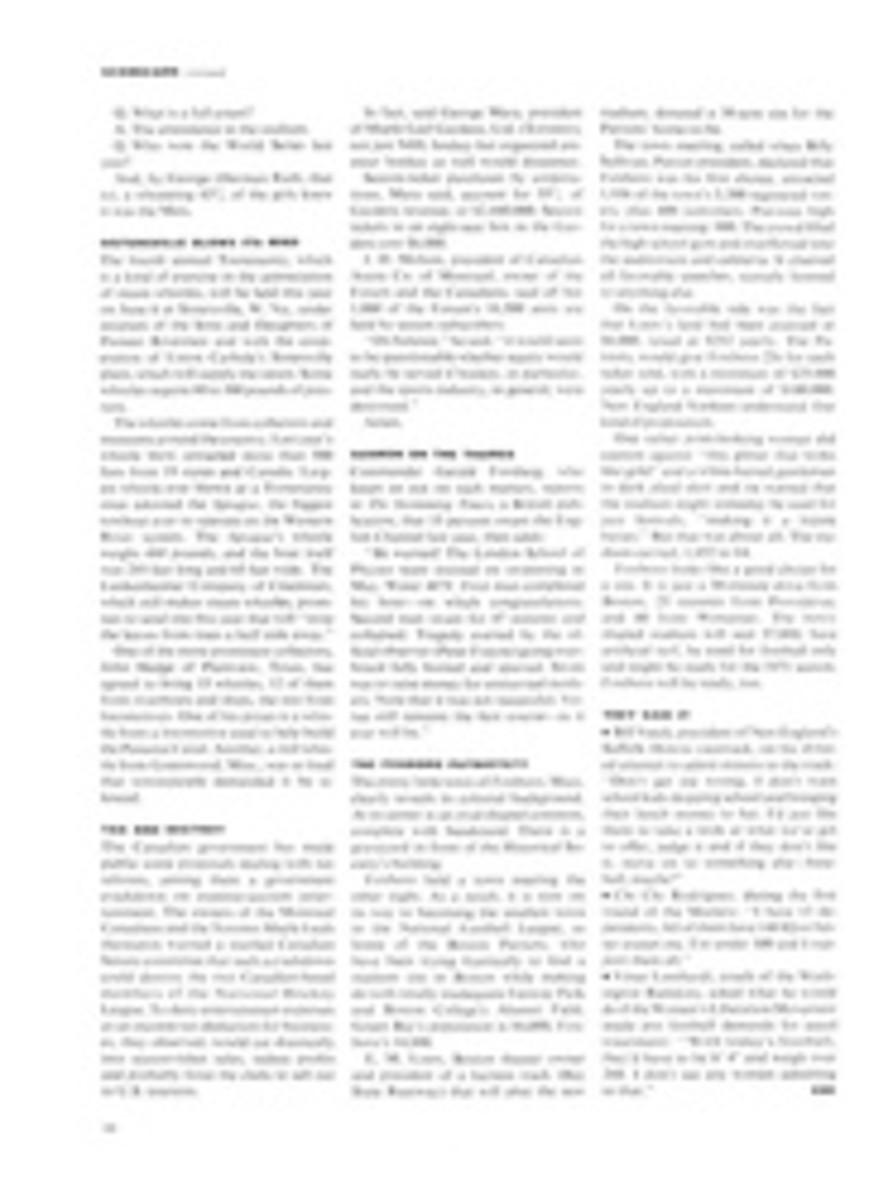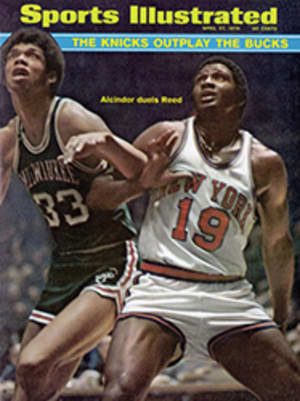
Milwaukee is falling in love quietly this time
Ray Jackson is again redecorating his restaurant across the street from the access road leading to Gate One at Milwaukee County Stadium. During the 13 seasons the Braves played in Milwaukee and drew the highest attendance in baseball, more fans bellied up to Jackson's bar before games than any other watering hole in town. In those days the place was festooned with players' autographs mounted in neat, framed plaques, caps arranged to show the standings in the National League and miscellaneous baseball paraphernalia. After the Braves moved to Atlanta in 1965, Jackson, like many Milwaukeeans, became disgusted not only with the Braves but baseball as well. Down came the old décor and up went murals of geisha and can-can girls. The patronage settled down to a tame, more profitable dinnertime trade.
Three weeks ago, after five years of false hopes and repeated frustrations, baseball abruptly returned to Milwaukee in the form of a new team called the Brewers (née Seattle Pilots). Ray Jackson and, apparently, the rest of Milwaukee quickly forgot their disgruntlement. By the start of the team's second home stand last week, plaques were back on the walls and caps were on the pegs. Not only had baseball come back, but excitement over the game had come with it. To old hands who remembered long lines of snake dancers weaving down Wisconsin Avenue celebrating the arrival of the Braves in 1953, the welcome for the Brewers seemed remarkably subdued, but the reticence appeared to indicate greater sophistication rather than less enthusiasm. "Instead of screaming and yelling, they're picking up the telephone and calling the ticket office," said a Brewers' official.
After a winter-long succession of starts and stops and a court action or two, the announcement of the transfer was made just a week before Opening Day. Ticket sales for the first game—to be played on a Tuesday—began on the Friday previous, and even though the only ticket outlets in the city were the mobbed windows at County Stadium, an impressive crowd of 37,237 attended. In the first 10 days of season-ticket sales, the Brewers sold over 4,000, nearly double the Braves' total in their first year.
"People who said they'd never go to a baseball game again have bought six or eight season tickets. They actually went down and stood on line to buy them," says Ray Jackson, who estimates he missed only 10 of the games the Braves played in Milwaukee and now has a season seat for the Brewers. "I got angry at the Braves. I got very mad at baseball. But I doubt that these guys will ever leave here and I think the public agrees with me. It's great to have a team again."
Convincing the fans that the team is here to stay was one of the main objectives of the Brewers' ownership, which is a group formed five years ago to lobby for a new Milwaukee team. Unlike the Braves, who were always controlled by absentee owners, the Brewers' stock is held almost exclusively by Wisconsin citizens. In the best deal since the Brinks robbery, the team has signed a 25-year lease for County Stadium at $1 a year (for years in which attendance does not exceed 1 million). One of the main reasons for the Braves' departure, a lucrative television contract in Atlanta that covered stations all over the Southeast, has been neutralized. Schlitz beer, which can hardly object to players running around with Milwaukee on their hats and Brewers written across their chest, has underwritten a five-year, $1.2 million-a-season radio and TV package.
In contrast to the Braves, who were an established club when they arrived in Milwaukee in 1953, the Brewers are a second-year expansion team whose greatest hope this year is merely to get out of the cellar, to which they established squatters' rights last year (and in which they were resting after 10 games this season). "We've openly told the fans not to expect too much," says Brewers President Bud Selig, a local Ford dealer who is baseball's youngest chief executive at 35. "That's why I feel the attitude now is better for us than it would have been if we had received the same reception the Braves did. There is something of a long-range, healthier feeling—no hysteria but deep enthusiasm. The town is going to have to grow with the team. They'll have to adopt new heroes and enjoy watching them develop."
A large number have already picked a player to watch. Surprisingly, in the second week of the season, the Brewers had the top men in the league in hitting, RBIs and home runs. Outfielder Steve Hovley, a 24-year-old graduate in history from Stanford, whacked line drives to all fields for his .436 average, but he was still playing second man to 22-year-old Leftfielder Danny Walton, the early leader in homers (4) and RBIs (13). Walton, who was the Minor League Player of the Year last season after hitting 25 home runs and driving in 119 runs at Oklahoma City, played only 23 games for Seattle late in 1969 and batted .217, but even so a special cheering section turned up to greet him at the airport carrying a "Dangerous Danny" banner. They were holdovers from the Rico Carty Fan Club, college and high school students who frequented the left-field bleachers and cheered Carty through long home runs and egregious fielding blunders during the Braves' final two seasons. When Walton strikes out he receives a standing ovation, just as he does when he hits a home run or simply trots to his position. "I didn't expect anything like this," Walton says. "They made me so nervous the first day it made the butterflies in my stomach feel like turkeys."
Walton did two things, aside from hitting those early homers, that endeared him to his new fans. First, he acknowledged their cheers on Opening Day by waving and giving the peace sign. Then he declared that his childhood idol was Eddie Mathews, who was the Braves' first Milwaukee hero when he arrived there in 1953 and led the league with 47 home runs. "Boy," says Walton, "47 taters and he was only 21. Wouldn't it be great to do something like that?"
It might be more than the young County Stadium bleacherites could stand. They were out in force again last week, stripped to the waist and guzzling beer and cheering during one game played in balmy 70° weather, and wrapped in blankets, guzzling beer with perhaps a side order or two of brandy and cheering during another when it was a marrow-curdling 36°. The revival of the student interest in baseball, so evident the past few years at Boston's Fenway Park, may be catching on in Milwaukee.
"The college kids can sit in the bleachers and drink beer and yell and scream at a baseball game," says Bill Kraus, a 24-year-old bartender at Someplace Else, a downtown singles hangout. "They can't do that at football because to get tickets to the Packer games here you have to know somebody. And there will be more kids out there soon because a lot of them have midterm exams now and everybody is pretty hung up on watching the Bucks in the NBA playoffs.
Although the last-minute transfer caused problems for some of the players, notably First Baseman Mike Hegan, who believed the American League when it said the team would remain in Seattle and bought a house there in which he has never lived and now never will, the move to Milwaukee was conducted with startling smoothness. There even has been time to work out a few promotions, and on May 14 the hated Atlanta Braves will come to Milwaukee for an exhibition game. Despite Ray Jackson sneering that "Bill Bartholomay [Braves' president] better not come here with them," County Stadium will be packed. Henry Aaron, who at that time will be just short of or just past his 3,000th hit, will be coming back, and it is clear that Milwaukee could never be so angry with the Braves that it would not want to come out and see Henry again.
PHOTO
HERO WALTON AND YOUTHFUL FANS

